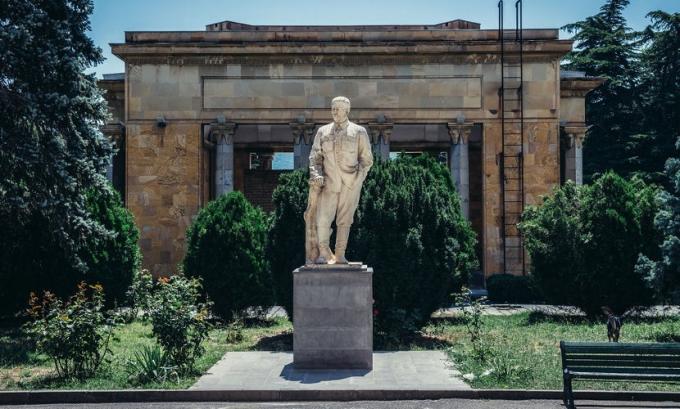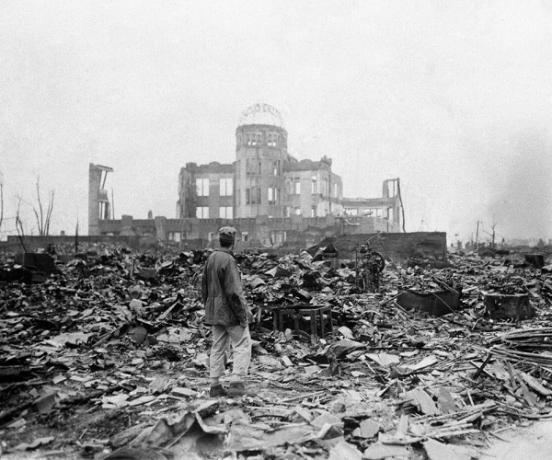Joseph Stalin he was marked in history as one of the best known dictators of the entire twentieth century. Stalin was a Georgian who worked with the Bolsheviks during the Russian Revolution of 1917. He rose in the ranks of the Communist Party as a excellent bureaucrat and this eventually brought him to power in the Soviet Union after Lenin died.
Stalin officially became ruler of the Soviet Union from 1927 and imposed a de facto dictatorial regime. Over nearly three decades in power, Stalin commanded a terror regime, persecuting ethnic minorities, ideological opponents and even supporters causing millions to be killed.
Accessalso: Sutinik, the first satellite sent by the Soviets in the 1950s
Stalin's youth

Stalin was born on December 18, 1878, in gori, city located in present-day Georgia, which at the time was a territory of the Russian Empire. His birth name was Iosif VissarionovichDzhugashvili. Stalin's father was called Vissarion Dzhugashvili (known as Besso) and his mother was called Ekaterina Georgievna Geladze (known as Keke).
Stalin's family was quite humble, since his father was a shoemaker and his mother worked as a laundress, cleaning lady and wet nurse. Besso and Keke's marriage was a problematic marriage, as Stalin's father was an alcoholic who constantly beat his wife and son. This ended up causing Besso and Keke to split up years later.
Stalin's father wanted his son to be a shoemaker, but his mother wanted him to be a religious priest of Orthodox Christianity. This led Stalin to join a schoolreligious located in Tiflis (now called Tbilisi) during her teenage years. For the first sixteen years of his life Stalin was raised and educated in Gori.
Despite his mother's wishes, Stalin was never a devotee of Christianity. Some biographers of Stalin report that, since his teens, he showed little affection for religion and manifested his lack of belief openly. An important mark of Stalin's adolescence is that his records as a student at Gori are that he was a good student.
Stalin's Revolutionaryism
During his years in the religious seminary, Stalin was affected by the climatepolitical that agitated Georgia, mainly because of the strengthening of the separatist movement in the region. During his years of study, Stalin associated himself with an orientation group social democrat which was called MessameDasi (translated as “third group”).
In 1899 Stalin was expelled from the religious seminary after failing to take the end-of-year examinations. During the seminar, he had had contact with Marxist readings and debates that started his path as a revolutionary. Later, he joined the Russian Social Democratic Workers' Party and went to work at the Tiflis meteorological observatory.
This job of Stalin's was a front to hide his revolutionary activity. As a militant, Stalin acted clandestinely in organizing workers' marches. Later he was assigned to lead study groups to teach basic concepts of Marxism to workers. In 1901, he was first noticed by Russian authorities and was pursued by the secret police.
The following year, in 1902, Stalin was stuck during actions he performed in Batum. On account of this prison, Stalin spent time in a prison in Batum and Kutaissi, both in Georgia, and then went sent to the exile in Siberia. This was the first of seven exiles that Stalin faced in his lifetime.
During Stalin's exile, the Social Democrats in Russia ended up splitting into two large groups. On one side were the revolutionaries Bolsheviks and, on the other, a group of moderate socialists who bore the name of the Mensheviks. In this division Stalin was aligned with the Bolsheviks. In February 1904 Stalin fled his exile and returned to Tiflis, Georgia.
From then on, he started to coordinate revolutionary actions in three important cities in the Caucasus: Tiflis, Baku and Batum. At 1905 revolution, Stalin wrote leaflets to incite the workers and was involved with the organization of peasants. Russian repression of demonstrations in the Caucasus was considerably violent. Still in 1905, something remarkable happened in Stalin's life: he personally met vladimirLenin, during a conference in Tampere, Finland.
Involvement in the Russian Revolution

In the 12 years separating the 1905 Revolution from the Bolshevik Revolution, Stalin was involved in numerous revolutionary actions and, as a result, was arrested and sent into exile several times. These actions, in turn, made him an important member of the Bolsheviks and, from 1912 onwards, he was invited to participate in the Central Committee of the Bolsheviks.
From 1912 he became responsible for editing the Bolshevik revolutionary newspaper called “Pravda”. Ahead of this newspaper, he started to sign its articles with the pseudonym of Stalin, Russian term that means “made of steel”. It was under this pseudonym that the Georgian became known internationally.
During the October Revolution, the revolution that brought the Bolsheviks to power in Russia in October 1917, biographers say that Stalin was involved in bureaucratic functions and nottook part in street actions in Petrograd (now St. Petersburg). After Lenin assumed power in Russia, Stalin joined important administrative positions.
From 1918 to 1922, he led the People's Commissariat for Nationalities and in that period he was one of the four most important men in the Soviet Union with Lenin, Trotsky and Sverdlov. He also played an important role during the years of Russian Civil War and was sent to southern Russia to coordinate actions against the Whites.
In 1920, he was nominated for the Commission for Workers and Peasant Inspection and continued to accumulate positions in the following years. Historian Lilly Marcou points out that, in 1922, Stalin had numerous functions within the Russian Communist Party and was a member of the Politburo (party committee), of the Orgburo (Politbuto subcommittee responsible for work-related decisions) and was general secretary of the party. In addition, he occupied the two commissions mentioned above and also participated in other councils|1|.
Accessalso: Soviet Union: Formation and History
Beginning of Stalin's dictatorship
From 1923, the Lenin's health declined rapidly and he died in early 1924 from a stroke. During the year 1923 Lenin had already tried to organize the succession of the Soviet Union and had even recommended that Stalin be removed from the post of General Secretary for being too rude.
Stalin was one of the postulants to succeed Lenin and, in 1924, he even offered to resign as secretary-general, but his opponents Trotsky, Kamenev, and Zinoviev refused to accept the Georgian's resignation. It was a gigantic strategic mistake on the part of the three who came under Stalin's persecution years later.
Stalin managed to establish himself in the Soviet Union command, because for years he served as a bureaucrat within the party and this secured him considerable support in the 1920s, after Lenin's death. In 1927, Stalin's three opponents were expelled from the Communist Party, and with it Stalin was made official as ruler of the Soviet Union.
Stalinism
Once established as ruler, Stalin imposed one of the best known totalitarian regimes of the entire 20th century. Stalin's regime, known as Stalinism, was a regime responsible for the deaths of up to 20 million people. Stalin persecuted ethnic minorities, opponents of his regime, and his paranoia led him to order them to kill even people who supported his regime.
Stalin carried out many reforms in the Soviet Union, carrying out the industrialization of the country and promoting the collectivization of agriculture. Industrialization took place through the plansQuinquennials, plans that stipulated goals to be achieved within a period of five years.
THE collectivization it happened through the nationalization of farmland in the Soviet Union and the persecution of wealthy farmers in the Soviet Union. Collectivization did not bring the expected results, as it disorganized Soviet agricultural production and caused thousands of people to die of hunger, mainly in Soviet Ukraine.
Stalin's regime was also marked by the persecution of minorities, especially to the Poles. These groups were sent to forced labor camps (known as Gulags), orthey were sent to be shot. In addition to ethnic minorities, Stalin ordered the persecution of the Soviet Union's rich classes and people who were critical of the regime.
In the 1930s, Stalin performed the great purge, a mass persecution that resulted in the death of thousands of people. Stalin had a paranoia that everyone conspired to overthrow him from power and this prompted him to order the execution of people close to him. Army wings and the interior of the Communist Party were disfigured with numerous of its members being executed.
Stalin was also branded for leading the Soviet Union during the Second World War. The Soviets were involved in controversial episodes in this conflict as the Polish massacre, in 1940, the war against Finland and the alliance with the nazis in 1939. From 1941 onwards, the Soviets became involved in the fight against the Germans.
Stalin managed to embody the endurance spirit on Soviet citizens and ordered the transfer of numerous Soviet factories to the east of the country and the summoning of millions of soldiers. In 1945, in an act of revenge, he managed to get only Soviet troops involved in the final attack on Berlin, the capital of Germany.
After the war, Stalin rose to the ranks of national heroes of the Soviet Union and was seen as largely responsible for leading his country to victory in World War II. In the post-war period, he was still secretly involved in Korean War, conflict between 1950 and 1953.
Accessalso: Discover one of the consequences of the collectivization of land in Soviet Ukraine
Stalin's death

In the 1950s Stalin's health began to deteriorate rapidly and he manifested numerous problems. On March 1, 1953, Stalin had a leakage and the lack of care he took during the period caused him to die on March 5, 1953. Lilly Marcou characterizes Stalin's death as the consequence of an omission to help.
After Stalin died, Soviet power passed to Nikita Khrushchev. The new Soviet ruler placed end the cult of Stalin through denunciations of his crimes during his nearly 30 years in power. Khrushchev's denunciations should have been secret, but they ended up being exposed and becoming known internationally.
Familiar life
In the course of his life Stalin married twice. his first wife was Ekaterina Svanidze (known as Kato), sister of a colleague of Stalin's at the religious seminary in Tiflis. In 1906, he secretly married Kato and from that marriage they had a son, named Yakov Dzhugashvili. In 1907 Stalin's wife passed away from typhus and Stalin's son was raised by his wife's sister.
In 1919 Stalin remarried. His second wife was called Nadezhda Alliluyeva, an 18-year-old Azeri girl who worked as Stalin's secretary. Nadezhda and Stalin had two children named Vasily and Svetlana. Their marriage, however, was an unhappy one, and on December 9, 1932, Nadezhda committedsuicide.
Image credits
[1] Kiev. Victor / Shutterstock
Grades
|1| IT IS, Lilly. Stalin's private life. Rio de Janeiro: Zahar, 2013.


